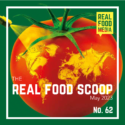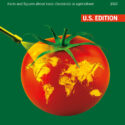We at Real Food Media have been trying to raise the alarm about the environmental impacts of the global food system since we launched more than 10 years ago.
In the ensuing decade, we have been thrilled to see the conversation about food systems grow—and so we were delighted to see the latest missive: The Washington Post’s feature on the environmental cost of the food we eat. But we were disappointed with its narrow focus. By pitting one food against another—rice or potatoes? salmon or cod?—the piece misses a big opportunity to help consumers think about the climate consequences of their food buying decisions.
One of the reasons our food system is a driver of environmental crises, including the climate crisis, is because of how food is grown, particularly our system’s dependence on the fossil-fuel based inputs of pesticides and synthetic fertilizer. Pesticides are fossil fuels in another form: 99 percent of all pesticides are derived from fossil fuels. And greenhouse gas emissions from nitrogen fertilizer alone are greater than all commercial aviation worldwide, noted a recent report by the Center for International Environmental Law. The good news is that, unlike aviation, we have technologies to free agriculture from fossil-fuel dependency through methods like organic and regenerative agriculture. Indeed, these production systems—that reduce the burden of costly and polluting inputs like pesticides and fertilizers—were identified as key climate solutions in a recent Intergovernmental Panel on Climate Change report. So for readers who want to lighten the environmental load of their diet, reaching for the organic label or seeking out products raised with regenerative practices is a powerful place to start.
We’re pleased to see mega-platforms like the Washington Post take on these big issues—we hope these deeper connections get exposed.
FYI — Unpublished LTE
As someone who has been trying to raise the alarm about the environmental impacts of the global food system for years, I was delighted to see The Washington Post’s headline: “This is the environmental cost of the food we eat.” But by pitting one food against another — rice or potatoes? salmon or cod? — the piece misses a big opportunity to help consumers think about the climate consequences of their food buying decisions. One of the biggest reasons our food system is a driver of environmental crises, including the climate crisis, is because of how food is grown, particularly our system’s dependence on the fossil-fuel based inputs of pesticides and synthetic fertilizer. Pesticides are fossil fuels in another form: 99 percent of all pesticides are derived from fossil fuels. And greenhouse gas emissions from nitrogen fertilizer alone are greater than all commercial aviation worldwide, noted a recent report by the Center for International Environmental Law. The good news is that, unlike aviation, we have technologies to free agriculture from fossil-fuel dependency through methods like organic and regenerative agriculture. Indeed, these production systems—that reduce the burden of costly and polluting inputs like pesticides and fertilizers—were identified as key climate solutions in a recent Intergovernmental Panel on Climate Change report. So for readers who want to lighten the environmental load of the foods they eat, reaching for the organic label or seeking out products raised with regenerative practices is a powerful place to start.
Anna Lappé | Founder and Strategic Advisor, Real Food Media |Author, Diet for a Hot Planet




